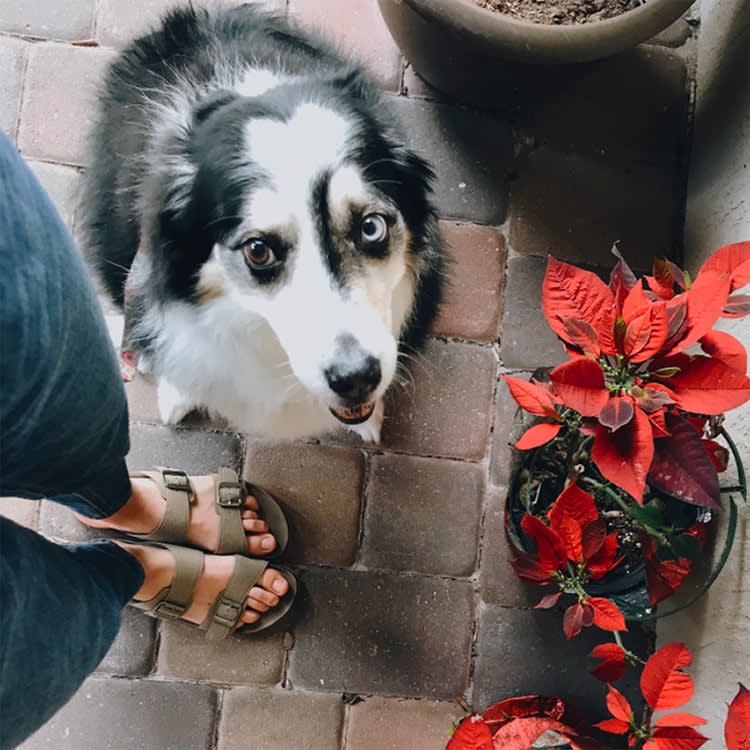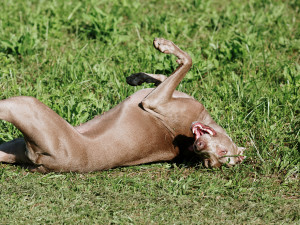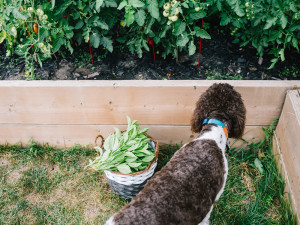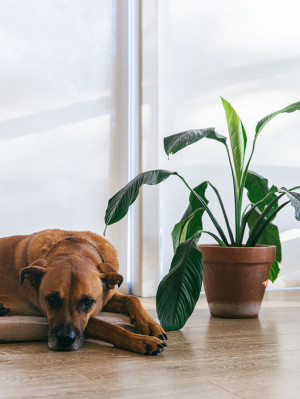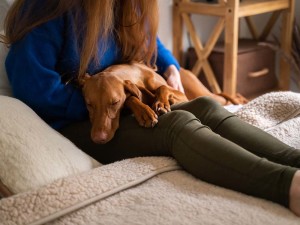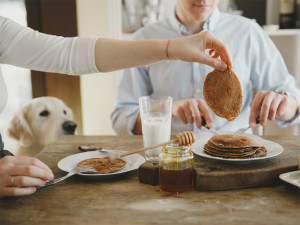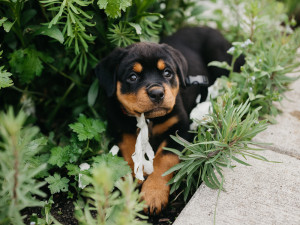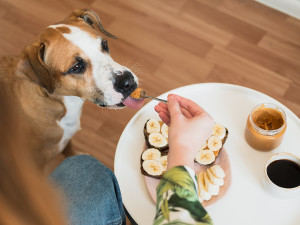Are Poinsettias Toxic For My Dog?
Everything you need to know about the notorious plant
Poinsettias come out at the end of every year, usually around the same time ‘Last Christmas’ starts climbing the charts again. With this in mind, you may have been cautioned to keep this particularly brightly hued plant away from your dog.
While poinsettias are technically considered a toxic plant for dogs, the symptoms they cause are mild. But let’s be clear, you should not poinsettias around your pup because of the issues they can cause.
Why are poinsettias dangerous to dogs?
Poinsettias contain a sap that can be irritating to the skin as well as to the mouth and digestive tract if ingested. The poinsettia is a member of the Euphorbia family of plants that are native to Mexico. They are popular houseplantsopens in new tab, especially around the winter holidays because they have very colourful foliage and are one of the few plants that bloom during the shorter days of winter.
The plant sap contains compounds called diterpenoid euphorbol esters as well as saponin-like detergents, which is a complex tongue twister of chemical components that cause its toxic effects. When these compounds come in contact with the skin or digestive tract, they are very irritating.
This can lead to a skin rash as well as inflammation within the mouth and digestive tract if ingested. While this is very unpleasant and likely something you’d hope to avoid for your pup’s sake, it is usually fairly mild and will resolve on its own.
What should I do if my dog has eaten a poinsettia?
If you catch your pup in the act of chomping on a poinsettia, do everything you can to remove the plant and minimise how much your dog actually eats. You can try to lure your pup away from the plant with a more enticing treat or toy and then clean up all the remnants of the plant so your dog doesn’t go back for seconds.
Wipe down their paws and mouth with a moist cloth as well as any other areas of their fur or skin that may have come into contact with the sap. If you see areas of sticky sap on their fur, you can also use a gentle dog shampoo or dish soap to remove all of the sappy residue – just keep it away from their mouth. If your dog will tolerate it, you can try to rinse their mouth out with cool water and to remove any remaining pieces of the plant and/or sap.
If you did not see your dog eating the plant but came home to find someone took a bite or two out of your poinsettia, you should still try to wipe down your dog’s mouth and paws to remove any sap that may irritate their skin. By that point, they may have already digested some of the plant, so you will have to monitor for additional signs of illness. If your dog does develop any concerning signs such as ongoing vomiting, diarrhoea, not eating, very red or painful skin, or lethargy, make sure to get your pup to the vet for treatment. Most cases are very mild, however, and will resolve without medical intervention.
Diagnosing plant poisoning in dogs
It is not always possible to make a definitive diagnosis of plant toxicity if the dog is not directly observed when eating the plant. This is because the signs are often non-specific, meaning they are signs that could be caused by many different medical problems. In the case of poinsettias, ingestion may cause vague signs such as a rash, vomiting, and/or diarrhoea. These same signs could be caused by infections, parasites, eating something funky from the trash, hormone disturbances, and more. For this reason, it is always best to see your vet if you are unsure what is up with your dog and the signs do not seem to be resolving quickly.
If you are suspicious that your dog ate a plant, it is also very helpful to bring a piece of the plant, a photo of the plant, and/or the name of the plant you think your dog ate with you to the vet. The more information you can provide, the better. It can also be useful to contact a pet poison helplineopens in new tab if you are unsure if the plant your dog ingested is toxic as they maintain a database of information to help determine the best course of action in these cases.
Symptoms of poinsettia poisoning in dogs
Poinsettias contain a sap that is irritating to the skin and any other tissues it comes into contact with. It can cause inflammation and swelling externally on the skin when a dog is chewing on the plant, especially around the face and paws as they tend to use their front paws to hold their catch while they are chewing.
Theoretically, it could get onto other parts of their fur and/or skin as well, so be sure to give your dog a thorough once-over if you think they may have been chewing on a poinsettia. The sap will also cause irritation within the digestive tract if it is swallowed, leading to signs of digestive upset as well. This includes:
Vomiting: dogs that ingest parts of the poinsettia plant may experience nausea and vomiting as a result of the toxic compounds in the sap. They also may not eat if they are feeling nauseous.
Diarrhoea: as the sap from the poinsettia is broken down in the digestive tract, it may cause inflammation within the intestines. This can disturb normal function of the intestines including water absorption and motility of the intestinal contents, leading to diarrhoea.
Drooling: excessive drooling may occur due to nausea, as well as irritation and pain of the tissues within the mouth. As dogs chew on poinsettias, the sap will be released and may irritate their mouth and tongue.
Itchy, red skin: any areas of the skin that come into contact with the poinsettia sap may become inflamed with a red, itchy rash. This would be most common around their mouth and front paws while they are chewing on the plant but could affect any area of exposed skin, and can also irritate human skin.
Eye irritation: if the sap comes into contact with your dog’s eyes, it can cause pain, redness and swelling. This should resolve on its own, but because eyes are so delicate, it is always best to check in with your vet whenever your dog has an eye injury.
Treatment
The good news is that the sap in poinsettias is considered a mild toxin, meaning that in most cases, your dog’s symptoms will resolve quickly on their own and will not require medical intervention.
If you are unsure why your dog is sick and/or did not directly observe your dog eating the poinsettia, it is better to have your dog examined by your vet right away than to wait and see how things progress. Some of these signs can also indicate a more serious medical problem, so don’t wait if you are concerned.
It is also important to see your vet if your dog’s signs do not resolve within 24 hours, or if your dog has more serious signs including not eating, seeming painful, acting lethargic, difficulty swallowing, trouble breathing or being unresponsive. These are not typical signs of poinsettia toxicity but could indicate a more serious medical problem.
How to prevent plant poisoning
The best way to prevent a plant toxicity is to keep toxic plants out of your home completely and only fill your home with safe, non-toxic plants. If you’re a sucker for those beautiful seasonal arrangements, or you receive one as a gift, be sure to double-check that it doesn’t contain other more toxic plants mixed in with the arrangement as well, and be sure to keep the plant completely out of reach of your pets. This means putting the plant in a room with a door that shuts securely and keeping your pets out of the room.
In general, it is a good idea to dog-proof your home to keep any potentially toxic or harmful items out of reach, as you just never know when your dog might get into some mischief. If you are traveling with your dog over the holidays, try to dog-proof your temporary digs as best as you can, and consider bringing along a crate for your dog to keep them safe when unsupervised. Crate training is a great way to keep your dog safe when you are not together, and it provides your dog with their own safe retreat if they need some alone time.
Are all parts of poinsettias toxic to dogs?
All parts of the poinsettia contain a sap comprised of diterpenoid euphorbol esters, as well as saponin-like detergents. These components are the toxic parts of the plant that can cause irritation and swelling to any tissues that they come into contact with. That said, no part of the plant is considered safe.
How do I stop my dog from eating poinsettias?
The best way to stop your dog from eating poinsettias or any other toxic plant is to keep them out of your home and therefore completely inaccessible to your dog. The next best option is to keep your dog securely separated from any poinsettias in your home by putting them in a separate room that is securely shut and/or keeping your dog in its crate when it is unsupervised.
It is also very handy to train your dog to respond to a ‘leave it’ cue. This can help in situations outside of your control where your dog may encounter something on a walk or at someone else’s home that is not safe for them to chew on. You can quickly use the cue to redirect their attention to a safe treat or toy.
The bottom line: are poinsettias poisonous for my dog?
Dogs should not have access to poinsettias. Because they can cause irritation to the skin once the sap is exposed, it is also a good idea for pet parents to wear gloves and wash up thoroughly after confiscating any pieces of chewed up poinsettia from their pups. The good news is that most cases of poinsettia toxicity are very mild and dogs tend to recover on their own very quickly.
It is important to monitor your pup closely for any of the more serious signs, though. As always, consult your vet right away if you are concerned or if you notice any signs of severe illness with your pup. It is best to play it safe and get medical attention for your pup sooner rather than later if you have concerns.
Other plants that are safe for dogs
If you want peace of mind with your foliage, consider adopting some non-toxic, pet-safe plants that won’t lead to an emergency vet visit if your dog takes a little nibble.
Parlour palm is a pet safe palm tree that is surprisingly easy to keep alive indoors even if your green thumb hasn’t bloomed yet.
Air plants don’t even need soil to grow. Talk about user-friendly. And even better, they are safe around pets.
Orchids have beautiful dramatic flowers and lush green leaves. They won’t make your pup sick, which may be their most alluring feature.
Other plants that are potentially dangerous
Some plants can cause more serious toxicities if ingested by dogs, so it is best to steer clear of these in your home.
Peace lilies are popular houseplants, but if you have pets, choose something else for your green decor. These plants contain calcium oxalate crystals that embed into tissues causing pain, swelling, and digestive problems.
Sago palms may be cute, but they contain a toxin called cycasin that can be lethal if ingested.
Aloe vera’s outer leaves contain a compound called anthraquinone glycosides, which can cause vomiting and diarrhoea when ingested.
Frequently asked questions
What happens if dogs eat poinsettias?
Dogs can develop a rash, vomiting, diarrhoea, and/or drooling from eating poinsettias because of irritants in the sap of the plant.
How much of the poinsettia is toxic to dogs?
Any amount can cause irritation because it is caused by direct contact with the sap. Signs are likely to be more severe the more a dog eats.
Are poinsettias poisonous to dogs?
Poinsettias are considered to be mildly toxic because they cause signs including rash, vomiting and diarrhoea. Most cases will resolve on their own without medical treatment.
Can poinsettias be toxic?
Poinsettias are toxic to dogs due to compounds in the sap. Most cases will be self-limiting in that they will resolve without medical treatment but may cause a rash, vomiting, diarrhoea, and/or drooling.
Can dogs eat poinsettias?
Dogs should not eat poinsettias, as they can cause mild toxicity. There are no benefits for dogs to eat poinsettias, and they can make them sick, so they should be avoided.
Can dogs eat poinsettias safely?
Dogs cannot safely eat poinsettias. They cause a mild toxicity when ingested as well as when the sap comes into contact with their skin.
Are poinsettias poisonous to dogs if they smell them?
Poinsettias are not poisonous if smelled, but if the sap comes into contact with a dog’s skin, it can cause a rash.
References
University of Minnesota Extension: Growing and Caring for Poinsettiasopens in new tab
Clinical Toxicology: Toxicology of Poinsettiaopens in new tab
